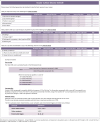Comparison of patient reported dry eye symptoms as evaluated by the ocular surface disease index and symptom assessment
- PMID: 40459105
- PMCID: PMC12135706
- DOI: 10.4102/phcfm.v17i1.4861
Comparison of patient reported dry eye symptoms as evaluated by the ocular surface disease index and symptom assessment
Abstract
Background: Dry eye disease (DED) is a growing public health problem because of excessive time spent on digital devices as a risk factor. The diagnosis of DED should not only be based on the objective clinical measures but also on symptoms reported by patients. Clinicians should not rely on establishing symptoms using open verbal questioning during the case history but should quantify patient symptoms using a validated questionnaire.
Aim: To compare the patient-reported symptoms of DED as assessed using the Ocular Surface Disease Index (OSDI) and Symptom Assessment in Dry Eye (SANDE).
Setting: An optometry clinic.
Methods: Ocular Surface Disease Index and SANDE questionnaires were administered to 40 participants. Participants completed all questionnaires in a non-randomised order. The correlation between the questionnaires' scores was determined and the Bland-Altman plot was used to assess the agreement between the two questionnaires.
Results: The mean scores for OSDI and SANDE were 37.85 ± 23.79 and 38.83 ± 26.39, respectively. The Spearman correlation between the two questionnaires was 0.7, p 0.01. The mean difference between OSDI and SANDE was -0.97 (95% Confidence Interval [CI]: [-7.04 to 5.09]). The Bland-Altman analysis between OSDI and SANDE showed a mean clinical difference (bias) of -0.98.
Conclusion: The SANDE questionnaire can be used as a dry eye symptom assessment as it is highly correlated to the OSDI questionnaire.Contribution: Because the OSDI and SANDE questionnaires showed a significant correlation and negligible score differences, this suggests that the SANDE questionnaire has the potential to provide clinicians with a short and quick measure of DED symptoms.
Keywords: dry eye disease; dry eye symptoms; ocular surface disease index; ocular surface disease.; questionnaire; symptom assessment in dry eye.
Conflict of interest statement
The authors declare that they have no financial or personal relationships that may have inappropriately influenced them in writing this article.
Figures




References
-
- Gantz L, Rosenfield M. Digital eye strain symptoms during online university learning in Israel and the USA during the COVID-19 pandemic. Invest Ophthalmol Vis Sci. 2021;62(8):1975.
Publication types
MeSH terms
LinkOut - more resources
Full Text Sources
